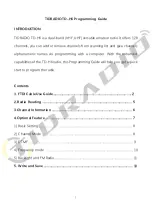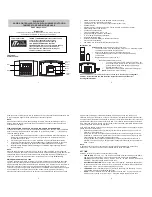
9
Engine Noise Suppression
Interference from the noise generated by the electrical systems of
engines is sometimes a problem with radios. The
VHF600
has been
designed to be essentially impervious to ignition noise and alternator
noise. However, in some installations it may be necessary to take
measures to further reduce the effect of noise interference. The
VHF600
radio DC battery wires, antenna lead, and accessory cables
should be routed away from the engine and engine compartment, and
from power cabling carrying high currents.
In severe cases of noise interference, it may be necessary to install a
noise suppression kit. Contact your West Marine store or dealer where
you purchased the radio for more information.
Antenna Considerations
A variety of antennas are available from a number of quality suppliers.
In general, we recommend 8’ 6dB rated antennas for powerboats, and 4’
3dB antennas for sailboats.
In general, communication range is increased by using a high-gain
antenna placed as high as possible above the water line. Antennas
should be located away from metal objects. Keep coax feed cables as
short as practical.
Antenna Selection and Installation
Your
VHF600
has been designed to accommodate all of the popular
marine VHF antennas. However, the selection and the installation of the
antenna is the responsibility of the user or installer.
The FCC has determined that excessive radiation poses a health risk to
people near radio transmitting antennas. Therefore, the antenna used
with this radio should be installed using the following guidelines to
ensure a suitable distance between the antenna and persons close by.
●
Small whip antennas (3 dB) or smaller should be installed keeping at
least 3 feet separation distance between the radiating element and
people.
●
Larger antennas (6 dB or 9 dB) should be installed keeping at least
a 6 feet separation distance.
●
No person should touch the antenna or come closer than the
separation distance when the radio is transmitting.
VHF600_UT921ZH 5/28/04 4:24 PM Page 9













































